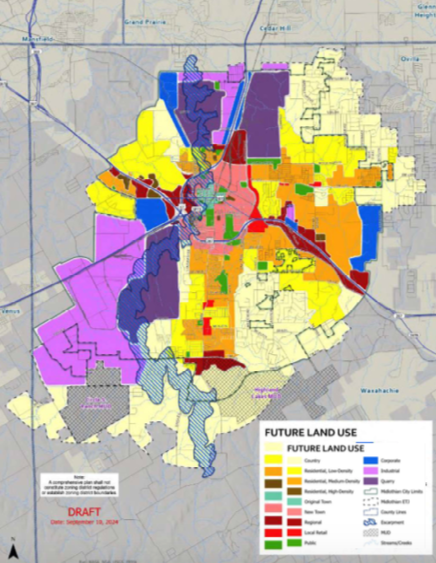
The city of Midlothian has had a comprehensive plan in place since 2018 to guide its growth. But an update to the plan has been in the works since early last year, and the Midlothian City Council is moving toward implementing tweaks it to keep it up to date.
The proposed update, dubbed “Guiding Our Future — Midlothian 2045 Comprehensive Plan,” is a wide-ranging proposal that includes city vision and guiding principles, revisions to the thoroughfare plan and land use plan, a comprehensive planning program, and official policy for the future of the city.
The City Council is expected to take up the final version of the plan, with changes suggested by councilmembers, at Tuesday’s regular bimonthly meeting.
The plan contains 158 actions and addresses how each action would be implemented. An incremental approach would be used based on priority and available resources. An annual status report would be presented to the City Council, and a formal audit of the plan would be carried out every five to seven years.
Daniel Harrison, project manager with consulting firm Freese & Nichols Inc., said the new plan has been in the works since February 2023 with numerous meetings by resident and stakeholder committees, joint City Council and Planning and Zoning workshops, and two community-wide open houses in consultation with Freese & Nichols.
As in the existing comprehensive plan, land areas are designated as “modules,” ranging from country to three residential densities, as well as “Original Town” and “New Town.” Each module is assigned appropriate uses.
Harrison said Midlothian has a projected total build-out population of 140,000, but that number is not expected to be reached until 2070. Previous projections had capped the build-out total at around 100,000.
The thoroughfare plan has a few changes from the existing plan, including the removal of Gifco Road as a future major collector. The trails and parks plan also contains updates.
Future housing policy is also one of the things that will be updated in the new plan. The city wants to set a lower target for standalone multifamily housing, with that form being reduced from about 12 percent of housing stock in the city down to 3 percent.
Among changes to the final draft, councilmember Ross Weaver objected to wording that encouraged “the implementation of clean energy alternatives in all aspects of life,” saying he wasn’t comfortable with that being included in the plan. Councilmembers agreed to remove the language from the document.
Weaver also sought more clarity on the placement of medium industrial uses in the country module, and on the size of multifamily units in the Original Town module.
More information is available at https://www.midlothian2045.com .



